
800 Township Line Road, Suite 300, Yardley, PA 19067
Toll Free: 866.933.0508
Fax: 267.756.1440
www.mccanntesting.com
college.measuredsuccess.com
© Copyright McCann Associates 2011. All Rights Reserved
Florida’s Postsecondary
Education Readiness Test
And Diagnostic Assessment
P.E.R.T.
December 12, 2011

370 Scotch Road, Ewing, NJ 08628
Toll Free: 866.933.0508
Fax: 267.756.1440
www.mccanntesting.com
college.measuredsuccess.com
© Copyright McCann Associates 2011. All Rights Reserved
2
Table of Contents
Introduction to the P.E.R.T .................................................................................................... 3
How the P.E.R.T. Works ....................................................................................................... 3
P.E.R.T Test-Taking Tips ...................................................................................................... 4
P.E.R.T. Subject Area Tests ................................................................................................... 4
What should you expect? ....................................................................................................... 5
Mathematics: .......................................................................................................................... 5
Math Sample Questions: ................................................................................................... 6
Reading: ................................................................................................................................. 9
Reading Sample Questions: .............................................................................................. 9
Writing: ................................................................................................................................ 14
Writing Sample Questions: ............................................................................................. 14
Answer keys: ........................................................................................................................ 18
Math: ............................................................................................................................... 18
Reading: .......................................................................................................................... 19
Writing: ........................................................................................................................... 20
Introduction to the Diagnostic Assessment.......................................................................... 21
P.E.R.T. Diagnostic Assessment.......................................................................................... 21
P.E.R.T. Diagnostic Assessment Content ............................................................................ 24
Lower Level Reading Diagnostic Competencies: ........................................................... 24
Upper Level Reading Diagnostic Competencies: ........................................................... 25
Lower Level Mathematics Diagnostic Competencies: ................................................... 26
Upper Level Mathematics Diagnostic Competencies: .................................................... 27
Lower Level Writing Diagnostic Competencies: ........................................................... 28
Upper Level Writing Diagnostic Competencies: ............................................................ 29
Sample P.E.R.T. Diagnostic Questions ............................................................................... 30
PERT Diagnostic Sample Mathematics Items ................................................................ 30
PERT Diagnostic Sample Reading Items ....................................................................... 31
PERT Diagnostic Sample Writing Items ........................................................................ 35
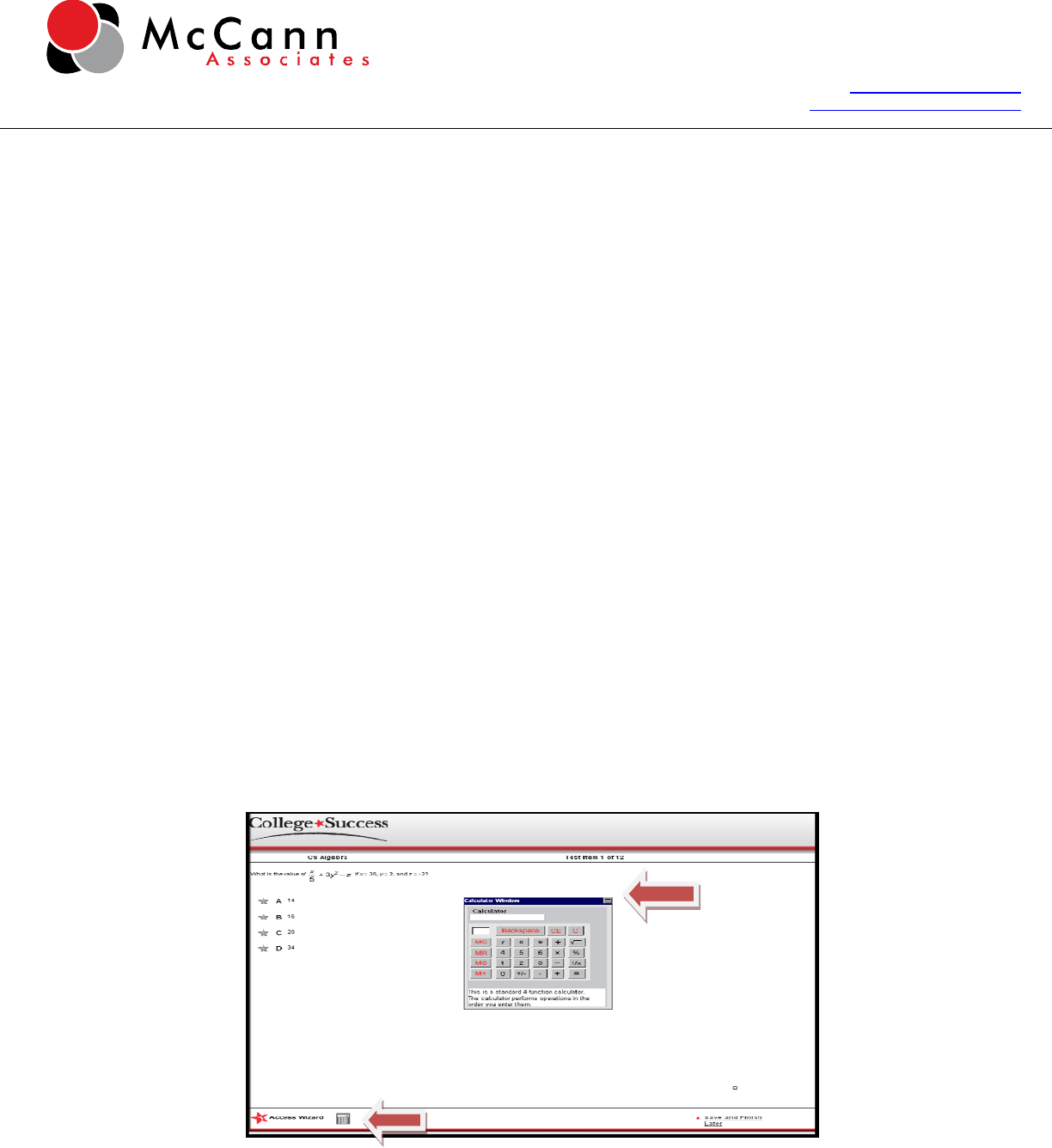
370 Scotch Road, Ewing, NJ 08628
Toll Free: 866.933.0508
Fax: 267.756.1440
www.mccanntesting.com
college.measuredsuccess.com
© Copyright McCann Associates 2011. All Rights Reserved
3
Introduction to the P.E.R.T
The purpose of Florida’s Postsecondary Education Readiness Test (P.E.R.T.) is to
adequately assess your academic skills in mathematics, reading and writing through the
delivery of three tests, one for each of these areas. The results of these tests are used to
determine your placement into appropriate courses at your college.
You cannot pass or fail the P.E.R.T. – it is only used to determine which courses are best
for you. While it doesn’t impact your grades, we encourage you to take the P.E.R.T.
seriously so that your course placement is accurate.
How the P.E.R.T. Works
The P.E.R.T. assessments are computer-adaptive, which means the questions are chosen
based on your answers to previous questions. You will not be permitted to change your
answer once you have moved on to the next question or leave a question unanswered.
However, all of the P.E.R.T. assessments are untimed so you have as much time as you
need to consider each question before submitting your answer. If you do not know the
answer to a specific question, you are encouraged to try and answer the question by
eliminating one or more of the answer options and then select from the remaining choices.
You will not be allowed to bring a calculator with you; however, for certain questions, a
calculator icon will be available in the bottom left corner of the test for your use. Once the
calculator icon has been clicked on, the electronic calculator will appear as a pop-up in the
middle of your screen. You must use the electronic calculator keyboard to input numbers.
It is a standard 4-function calculator and performs operations in the order you enter them.

370 Scotch Road, Ewing, NJ 08628
Toll Free: 866.933.0508
Fax: 267.756.1440
www.mccanntesting.com
college.measuredsuccess.com
© Copyright McCann Associates 2011. All Rights Reserved
4
Check with your college testing center for what to bring or not to bring with you on test
day.
Your scores on each assessment will be available immediately after you submit and your
college will provide you with the results.
P.E.R.T Test-Taking Tips
Prepare
Take practice exams and study areas of weakness.
Read the directions carefully
When you take the tests, make sure to take your time and carefully follow the
instructions for each question.
Use reasoning when answering
1. Identify the key phrase in the question.
2. Try to find the correct answer before you read all the choices.
3. Eliminate the choices that you know are not correct.
4. Read all the choices and pick the best answer.
Review
Be sure to review each answer carefully before submitting. You will not be able to
go back to any questions.
P.E.R.T. Subject Area Tests
There are three P.E.R.T. tests, each with 30 questions. The content that is covered is listed
below by subject:
Mathematics:
Equations–solving linear equations, linear inequalities, quadratic equations and
literal equations
Evaluating algebraic expressions
Polynomials–factoring, simplifying, adding, subtracting, multiplying, and dividing
Dividing by monomials and binomials
Applying standard algorithms or concepts
Coordinate planes–translate between lines and inspect equations
Focusing on pairs of simultaneous linear equations in two variables
Reading:
Discerning and summarizing the most important ideas, events, or information
Supporting or challenging assertions about the text
Determining the meaning of words and phrases in context
Analyzing the meaning, word choices, tone, and organizational structure of the text

370 Scotch Road, Ewing, NJ 08628
Toll Free: 866.933.0508
Fax: 267.756.1440
www.mccanntesting.com
college.measuredsuccess.com
© Copyright McCann Associates 2011. All Rights Reserved
5
Determining the author’s purpose, and the relation of events in the text to one
another
Recognizing relationships within and between sentences
Analyzing the traits, motivations, and thoughts of individuals in fiction and
nonfiction
Analyzing how two or more texts with different styles, points of view, or arguments
address similar topics or themes
Distinguishing between facts and opinions
Evaluating reasoning and rhetoric of an argument or explanation
Writing:
Sustaining focus on a specific topic or argument
Establishing a topic or thesis
Demonstrating use of the conventions of standard written English, including
grammar, usage, and mechanics
Supporting and illustrating arguments and explanations
Developing and maintaining a style and tone
Synthesizing information from multiple relevant sources
Conveying complex information clearly and coherently
Representing and accurately citing data, conclusions, and opinions of others
Establishing a substantive claim and acknowledging competing arguments or
information
Conceptual and Organizational Skills - recognizing effective transitional devices
within the context of a passage
Word Choice Skills - recognizing commonly confused or misused words and
phrases
Sentence Structure Skills - using modifiers correctly, using coordination and
subordination effectively, recognizing parallel structure
Grammar, Spelling, Capitalization, Punctuation Skills - avoiding inappropriate
shifts in verb tense and pronouns; maintaining agreement between pronoun and
antecedent; and using proper case forms, adjectives, and adverbs
What should you expect?
The following section provides an overview of the type of information you will need to
know to perform well on the subject area tests but it is not intended to be a comprehensive
listing of all content to be covered.
Mathematics:
You should review your basic math rules such as, the order of operations, exponents, prime
numbers and percents. Here are a few of the rules to review:

370 Scotch Road, Ewing, NJ 08628
Toll Free: 866.933.0508
Fax: 267.756.1440
www.mccanntesting.com
college.measuredsuccess.com
© Copyright McCann Associates 2011. All Rights Reserved
6
Order of Operations
work within parentheses
simplify exponents
multiplication and division
addition and subtraction
Exponents
The mathematical notation that notates a variable is multiplied by itself the number of
times indicated by the exponent.
x
3
= x × x × x
x
5
= x × x × x × x × x
Prime Numbers
A prime number is defined as an integer that is greater than 1, and has only two positive
factors, 1 and itself. The first ten prime numbers are 2, 3, 5, 7, 11, 13, 17, 19, 23, and
29.
Percents
The word percent means “hundredths” or a number which is divided by 100.
Converting a number into a percentage involves multiplying the number by 100.
A percent can be determined by performing the division of the part by the total and
multiplying it by 100:
Percent = Part x 100
Total
Math Sample Questions:
1. Which of the following is a solution to the equation c + (4 – 3c) – 2 = 0?
A. -1
B. 0
C. 1
D. 2
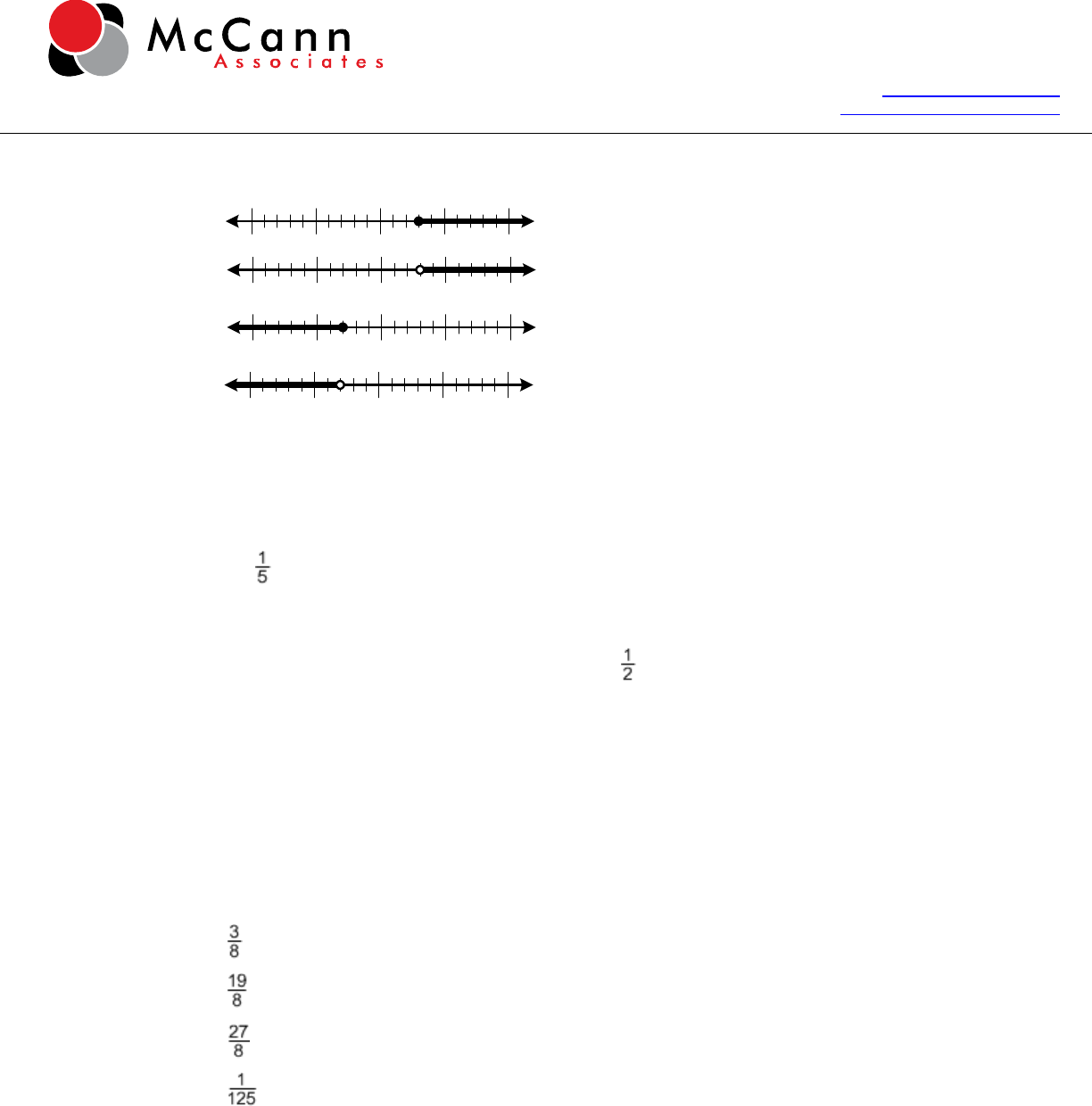
370 Scotch Road, Ewing, NJ 08628
Toll Free: 866.933.0508
Fax: 267.756.1440
www.mccanntesting.com
college.measuredsuccess.com
© Copyright McCann Associates 2011. All Rights Reserved
7
0-5-10 105
0-5-10 105
0-5-10 105
0-5-10 105
2. Graph the solution of y – 2 > 1 on a number line.
A.
B.
C.
D.
3. Which of the following is a solution to the equation x
2
– 6x + 5 = 0?
A. x = -5
B. x = -1
C. x =
D. x = 5
4. What is the value of the algebraic expression if x = , y = -1, and z = 2?
6x(y
2
z)
A. -12
B. -6
C. 1
D. 6
5. Which of the following is equivalent to (8 – 5) ÷ 2
3
?
A.
B.
C.
D.
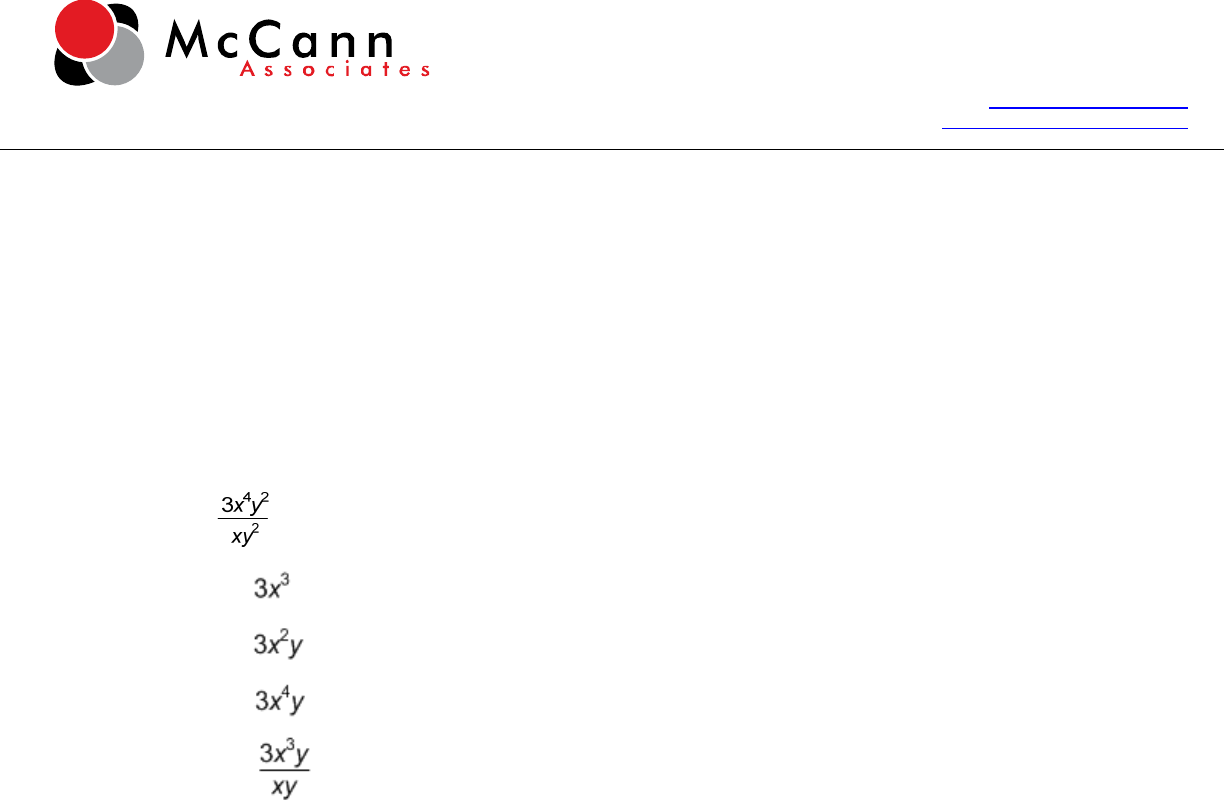
370 Scotch Road, Ewing, NJ 08628
Toll Free: 866.933.0508
Fax: 267.756.1440
www.mccanntesting.com
college.measuredsuccess.com
© Copyright McCann Associates 2011. All Rights Reserved
8
6. Factor completely:
x
2
– x – 6?
A. (x – 2)(x + 3)
B. (x – 1)(x – 6)
C. (x + 2)(x – 3)
D. (x + 1)(x – 6)
7. Simplify the following expression:
A.
B.
C.
D.
8. Which of the following is equivalent to the expression (3ab)(-5ab)?
A. -2ab
B. -2a
2
b
2
C. -15ab
D. -15a
2
b
2
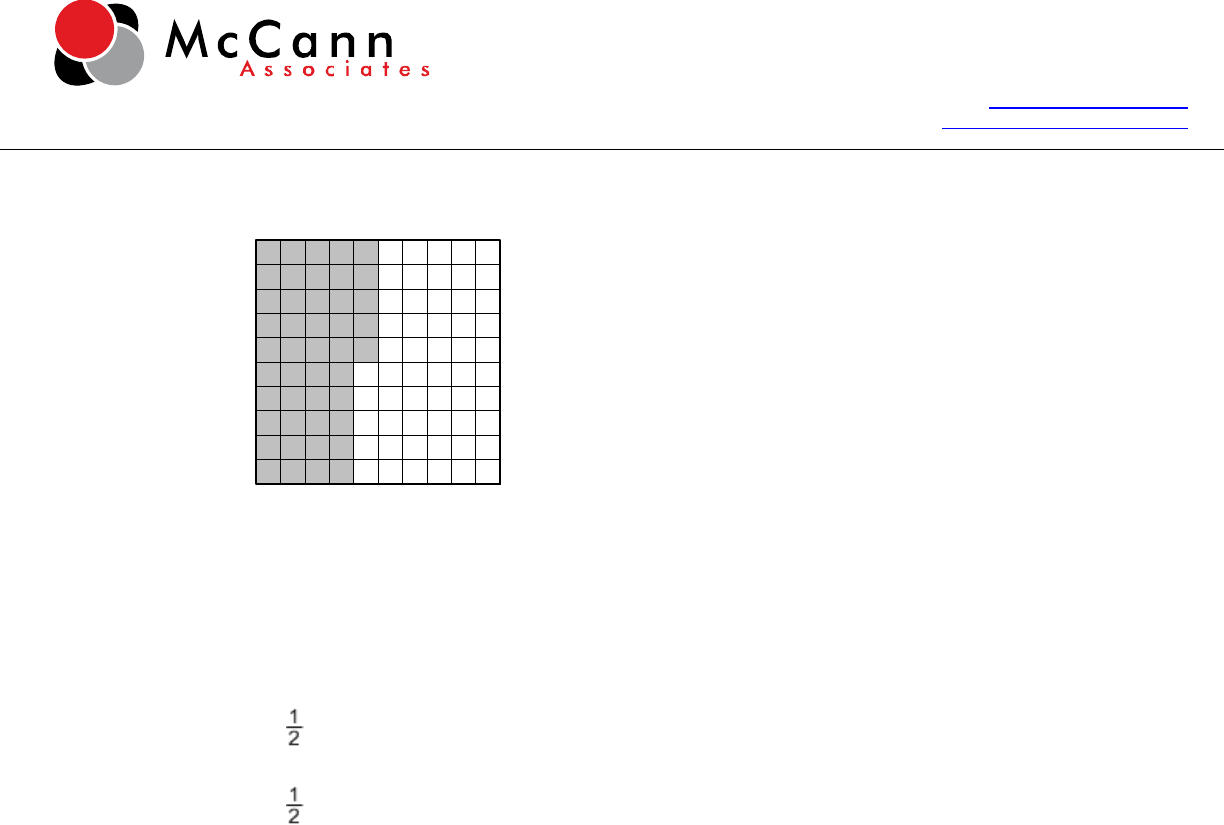
370 Scotch Road, Ewing, NJ 08628
Toll Free: 866.933.0508
Fax: 267.756.1440
www.mccanntesting.com
college.measuredsuccess.com
© Copyright McCann Associates 2011. All Rights Reserved
9
9. What percent of the grid is shaded?
A. 35%
B. 40%
C. 45%
D. 55%
10. Which of the following is the equation of a line that passes through (-2, -1) and (-4, -3)?
A. y = x + 1
B. y = x + 1
C. y = x – 1
D. y = x – 1
Reading:
Read each passage carefully. Since the test is not timed, take as much time as you need to
read each passage. Each passage may have one or more than questions associated with it. It
is also important to focus on the opening and ending sentences of each paragraph to help
with capturing the main idea of each paragraph. Another strategy is to look for keywords or
key phrases within the passage to help find the answer to questions regarding the author’s
feelings or meaning of the passage.
Reading Sample Questions:
Read the selection and answer the questions that follow.
A Born Artist
Benjamin West was born in a small town near Philadelphia, Pennsylvania, in 1738.
Soon after Benjamin's birth, the family minister paid a visit. "This boy will do great

370 Scotch Road, Ewing, NJ 08628
Toll Free: 866.933.0508
Fax: 267.756.1440
www.mccanntesting.com
college.measuredsuccess.com
© Copyright McCann Associates 2011. All Rights Reserved
10
things someday," the minister said. The minister's words left the Wests wondering what
might be in store for their son. Then, when Benjamin was seven years old, he drew a
picture of his baby niece. Benjamin's parents were stunned to see how skilled his
drawing was. Perhaps it is a sign, they thought.
As he grew up, Benjamin drew whenever he could. He especially liked drawing
animals he saw in the fields and woods near his house. One day, as Benjamin was
drawing a robin, three Lenape Indians passed by. They looked at the drawing and, in
their own language, discussed what was wrong with it. Finally, one of the Lenape told
Benjamin in English that the robin's breast should be red. When Benjamin explained
that he didn't have any paint, the Lenapes dug some red and yellow clay from the
riverbank and showed him how to make paint from the clay.
Benjamin ran home with his red and yellow paints. When his mother saw how
excited he was, she gave him some blue indigo, which she used to dye wool. Now
Benjamin had the three primary colors, which he could mix to make other paint colors.
But Benjamin still needed a brush. There was no place around to buy one, so Benjamin
decided to make his own. When his parents weren't looking, he snipped some hair from
his cat's tail. Then he pressed the hairs to the tip of a goose quill and wound yarn
around the tip to secure the hairs.
The brush worked, but not for long. After it fell apart, Benjamin made more. Soon
Mr. and Mrs. West saw that the family cat was missing great patches of fur. At first
they were furious, but then they softened. They knew that a boy who would go to such
lengths to paint must be special. So they bought Benjamin paints, brushes, and some
canvas.
From these beginnings, Benjamin West became a great and famous painter. In 1763
he moved to England and never returned to America. Although he taught himself to
paint, he was happy to teach younger artists, especially ones who traveled from the
United States to study with him. For this reason, West is often called the father of
American art.
1. Which of the following statements is the best
summary of this selection?
A. Benjamin West drew pictures of his niece and a robin. Then he became interested in
painting instead.
B. As a young child, Benjamin West loved to draw and paint. He grew up to become a
great and famous painter.
C. Benjamin West taught himself to draw. Then some Indian friends and his parents
gave him painting supplies.
D. A minister predicted that Benjamin West would do great things someday. His
parents soon discovered that Benjamin was special.

370 Scotch Road, Ewing, NJ 08628
Toll Free: 866.933.0508
Fax: 267.756.1440
www.mccanntesting.com
college.measuredsuccess.com
© Copyright McCann Associates 2011. All Rights Reserved
11
2. How is the information in this selection organized?
A. In chronological order
B. As a list of problems and solutions
C. In a series of questions and answers
D. From least important to most important
3. As it is used in this selection, the word secure means —
A. free from danger.
B. to take or get.
C. sure or certain.
D. to fasten or hold tight.
4. The author’s main purpose in writing this selection was to —
A. persuade young artists to keep drawing.
B. show that art supplies can be made from everyday things.
C. entertain with a story about a young artist.
D. inform readers about art long ago.
Read the selection and answer the questions that follow.
King of the Sea
Thor Heyerdahl, a famous adventurer from Norway, could not swim. He nearly
drowned more than once when he was a teenager. For a long time he was afraid of
water. It's surprising, then, to learn that he spent much of his life sailing delicate boats
on the world's oceans.
In 1947, Heyerdahl set off on his first great adventure. He hoped to cross the Pacific
Ocean from South America to Polynesia. Heyerdahl thought that early people might
have migrated to Polynesia thousands of years ago by sea. He reasoned that if he could
follow this route in a simple raft, he would show it was possible.
Heyerdahl constructed a raft of balsa wood and set out to cross the Pacific Ocean.
This wood is so light that today it is used for model airplanes. Critics thought the raft
would get waterlogged and sink, but they were wrong. The raft, called the Kon-Tiki,
landed in Polynesia after about 100 days at sea.
On another trip, in 1969, Heyerdahl tried to sail across the Atlantic Ocean from
North Africa to the Caribbean. His first boat for this trip was the Ra; it was made of
reeds. The design was based on ancient drawings found on a wall in Egypt. After the

370 Scotch Road, Ewing, NJ 08628
Toll Free: 866.933.0508
Fax: 267.756.1440
www.mccanntesting.com
college.measuredsuccess.com
© Copyright McCann Associates 2011. All Rights Reserved
12
Ra broke apart, Heyerdahl did not give up. A year later, he set off in a new boat, called
the Ra II, and made the 3200-mile trip successfully.
The Norwegian explorer became well known through the books he wrote about his
adventures at sea. His book about the voyage in the Kon-Tiki sold 25 million copies.
Heyerdahl believed that his voyages proved his theory that peoples of long ago
sailed to distant places. This could explain why similar cultures have shown up in
places that were far removed from each other. For example, it could explain why
pyramids are found both in Egypt and in Mexico, even though these countries are on
opposite sides of the world.
Today, experts don't generally accept Heyerdahl's voyages as proof of his theories.
Still, he is viewed as a remarkable sea-going explorer, and that's not bad for a boy who
was once afraid of the water.
5. Which evidence in this selection best supports the theory that people migrated across
the Atlantic Ocean thousands of years ago?
A. Heyerdahl made a raft of balsa wood found in South America.
B. The Ra was based on a design from a drawing found in Egypt.
C. Heyerdahl made a boat of reeds, but it broke apart.
D. Ancient pyramids have been found in both Mexico and Egypt.
6. In what way were the two voyages described in this selection alike?
A. Heyerdahl used the same boat for both voyages.
B. Heyerdahl was trying to prove the same theory on both voyages.
C. Both voyages followed the same route.
D. Both voyages succeeded on the first attempt.
7. According to this passage, the purpose of Heyerdahl's first voyage in 1947 was to —
A. sail across the Atlantic Ocean in a reed boat.
B. prove you can become famous by sailing long distances.
C. learn how to build a simple raft of balsa wood.
D. show that the Polynesians could have crossed the Pacific Ocean.

370 Scotch Road, Ewing, NJ 08628
Toll Free: 866.933.0508
Fax: 267.756.1440
www.mccanntesting.com
college.measuredsuccess.com
© Copyright McCann Associates 2011. All Rights Reserved
13
Read the selection and answer the questions that follow.
Sacajawea Saves the Day
The baby squirmed in his basket, and Sacajawea hummed quietly to soothe him. At
three months old, he was a strong, healthy child and was already used to life in the
wilderness. The young mother knew the little boy would soon fall into a peaceful sleep,
lulled by the rocking motion of the river. Sacajawea closed her eyes and rested. She
carried little Pompy on her back night and day, yet she never failed to keep up with her
companions. Under the leadership of Lewis and Clark, she and a large band of men
were on a great journey to explore the western wilderness.
For now, things were going well. Just that morning Sacajawea had found an
abundant supply of edible roots—enough to satisfy the hunger of all the men in the
group. Captain Clark had praised her warmly and recorded the event in his journal. The
men, at first suspicious of the Shoshone woman with the child, now welcomed her as an
important member of the group.
Sacajawea dozed quietly until a sudden clap of thunder awakened her. Rain began
to fall, and a sudden strong wind nearly knocked her over. The boat tipped. Bundles of
supplies slid toward the water. Suddenly the boat overturned, and Sacajawea fell into
the river. She struggled to keep Pompy's head above the rushing water. Captain Clark
shouted; another man screamed. Sacajawea reached for her son, strapped in the basket
on her back. A wail told her that he was fine, though cold and wet.
The water was not deep, but the current was strong. The men worked frantically to
right the overturned boat. No one but Sacajawea noticed the bundles bobbing in the
water. As they spun farther away from the boat, Sacajawea grabbed an overhanging
branch, and quickly lowered the branch to trap the bundles. When the boat was finally
right-side up, Sacajawea quietly placed the precious bundles inside.
8. Where does this story take place?
A. In Sacajawea's village
B. On a river in the wilderness
C. In a mountain pass
D. At a fort on the frontier
9. The writer of this selection seems to view Sacajawea with a feeling of —
A. admiration.
B. amusement.
C. dislike.
D. confusion.

370 Scotch Road, Ewing, NJ 08628
Toll Free: 866.933.0508
Fax: 267.756.1440
www.mccanntesting.com
college.measuredsuccess.com
© Copyright McCann Associates 2011. All Rights Reserved
14
10. Which of the following is the best description of the theme of this selection?
A. Only the strong survive.
B. A penny saved is a penny earned.
C. One person can make a difference.
D. Practice makes perfect.
Writing:
Review basic writing rules such as errors in word choice, punctuation and capitalization.
You may want to look over materials on when and how apostrophes and commas should be
used as well as reviewing common sentence structure errors.
Writing Sample Questions:
Read the selection about American astronaut Sally Ride and answer the question.
(1) Some of the greatest success stories in American history began with failure. (2) Take
the case of Sally Ride. (3) When Ride was a young girl in Encino, California, her goal
was to become a professional tennis player. (4) She dropped out of college and practiced
hard to become a tennis pro. (5) In time, she realized that she would never be good
enough to compete with the best tennis players. (6) She returned to college and studied
astrophysics.
(7) One day in 1977, while working on her Ph.D. at Stanford University, Ride read that
NASA was looking for astronauts. (8) She applied and was one of six women accepted
into the space program. (9) Ride trained to be an astronaut longer and harder than she
had ever done anything in her life. (10) By the early 1980s, she was part of the space
shuttle program. (11) In 1983, as a member of the crew of the space shuttle Challenger,
Sally Ride became the first American woman to journey into space.
(12) Ride was getting ready for another mission when the Challenger exploded in 1986,
killing the whole crew. (13) One of them was a New Hampshire high school teacher
named Christa McAuliffe. (14) Ride was appointed to a special commission that
investigated the tragic accident. (15) A year later she retired from NASA and returned to
California, where she taught college. (16) Since then, she has been involved in several
organizations that encourage girls who are interested in science and math.

370 Scotch Road, Ewing, NJ 08628
Toll Free: 866.933.0508
Fax: 267.756.1440
www.mccanntesting.com
college.measuredsuccess.com
© Copyright McCann Associates 2011. All Rights Reserved
15
1. Which sentence does NOT belong in the selection?
A. Sentence 4
B. Sentence 6
C. Sentence 13
D. Sentence 15
2. Choose the word that best completes the sentence.
Harold’s grandmother entertained the families with stories ______ growing up in
Africa, explaining the many differences between her life now and her life back then.
A. about
B. within
C. between
D. throughout
3. Choose the sentences that best support the following topic sentence:
Hay fever is the common name for an allergic reaction to pollen.
A. In my father's family, allergies are quite common. His sister Jane is allergic to dust,
pollen, and mold, as well as foods such as tomatoes and eggplant.
B. It seems that allergic reactions to peanuts and tree nuts are becoming more and
more common, too. Many schools have recently banned peanuts and peanut butter
altogether.
C. People who suffer from allergies can check the weather report in our newspaper for
the allergen counts. The weather page also includes interesting information about
the phases of the moon and the times of sunrise and sunset.
D. The worst offender is ragweed pollen, which causes many people to suffer from
sneezing, runny nose, and itchy eyes from late summer to late fall. Dust and animal
dander may also bring on the symptoms of hay fever.

370 Scotch Road, Ewing, NJ 08628
Toll Free: 866.933.0508
Fax: 267.756.1440
www.mccanntesting.com
college.measuredsuccess.com
© Copyright McCann Associates 2011. All Rights Reserved
16
4. Choose the best order of the sentences in the paragraph.
A. Before long, the storm moved on, and all was quiet again. From my window, I
watched bright lightning bolts streak across the sky. After each lightning flash, the
thunder boomed loudly. Last night a powerful thunderstorm rolled through our
town.
B. From my window, I watched bright lightning bolts streak across the sky. Last night
a powerful thunderstorm rolled through our town. Before long, the storm moved on,
and all was quiet again. After each lightning flash, the thunder boomed loudly.
C. Last night a powerful thunderstorm rolled through our town. From my window, I
watched bright lightning bolts streak across the sky. After each lightning flash, the
thunder boomed loudly. Before long, the storm moved on, and all was quiet again.
D. After each lightning flash, the thunder boomed loudly. Before long, the storm
moved on, and all was quiet again. Last night a powerful thunderstorm rolled
through our town. From my window, I watched bright lightning bolts streak across
the sky.
5. Choose the sentence that is written correctly.
A. Roasted with garlic, Abby decided to order the potatoes with dinner.
B. Abby decided to order the roasted garlic potatoes with dinner.
C. Deciding to order with dinner, the roasted garlic potatoes were what Abby decided
on.
D.
Ordered with dinner, Abby decided on the roasted garlic potatoes.
6. In researching granite, a research paper is located that includes the following
information:
Granite is a hard, coarse rock. It is formed by the slow cooling of magma under the
earth's surface. The main minerals in granite are quartz and feldspar. It contains smaller
amounts of mica and hornblende.
Granite's hardness makes it a popular building stone. It can be polished to a shiny finish
and will stand up to centuries of weathering.
Which of the following notes should be taken to reference what granite is made of?
A. Granite is hard and coarse.
B. Granite forms under the surface of the earth.
C. Granite can be polished and is a popular building stone.
D. Granite contains quartz, feldspar, mica, and hornblende.

370 Scotch Road, Ewing, NJ 08628
Toll Free: 866.933.0508
Fax: 267.756.1440
www.mccanntesting.com
college.measuredsuccess.com
© Copyright McCann Associates 2011. All Rights Reserved
17
7. Choose the word or words that best complete the sentence.
Until it was actually mapped, only a few people ________ the true location of the
tunnel.
A. knew
B. had known
C. have known
D. will know
8. Choose the word that best completes the sentence.
Janine claims that Gary and ______ saw the meteorite while camping in the mountains
last night.
A. she
B. he
C. her
D. him
9. Which of the following sentences is written correctly?
A. Each member of the jury is permitted to talk about the case, but it must do so only
in the company of the other jurors.
B. Each member of the jury is permitted to talk about the case, but they must do so
only in the company of the other jurors.
C. Each member of the jury is permitted to talk about the case, but we must do so only
in the company of the other jurors.
D. Each member of the jury is permitted to talk about the case, but he or she must do
so only in the company of the other jurors.
10. Choose the word or words that best complete the sentence.
Due to library policy, patrons must set cell phones to vibrate and speak ________ in
conversation.
A. quieter
B. more quiet
C. quietly
D. more quieter

370 Scotch Road, Ewing, NJ 08628
Toll Free: 866.933.0508
Fax: 267.756.1440
www.mccanntesting.com
college.measuredsuccess.com
© Copyright McCann Associates 2011. All Rights Reserved
18
Answer keys:
Math:
Sequence Competency Description Key
1 Solve linear equations in one variable using
manipulations guided by the rules of arithmetic and the
properties of equality.
C
2 Solve linear inequalities in one variable and graph the
solution set on a number line.
B
3 Solve quadratic equations in one variable by factoring. D
4 Evaluates algebraic expressions. D
5 Applies the order-of-operations to evaluate algebraic
expressions, including those with parentheses and
exponents.
A
6 Factor polynomial expressions. C
7 Simplifies an expression with integer exponents. A
8 Add, subtract, multiply, and divide polynomials.
Division by monomials and binomials.
D
9 Know when and how to apply standard algorithms or
concepts, and perform them flexibly, accurately and
efficiently.
C
10 Translate fluently between lines in the coordinate plane
and their equations. Include predicting visual features
of lines by inspection of their equations, determining
the equation of the line through two given points, and
determining the equation of the line with a given slope
passing through a given point.
B
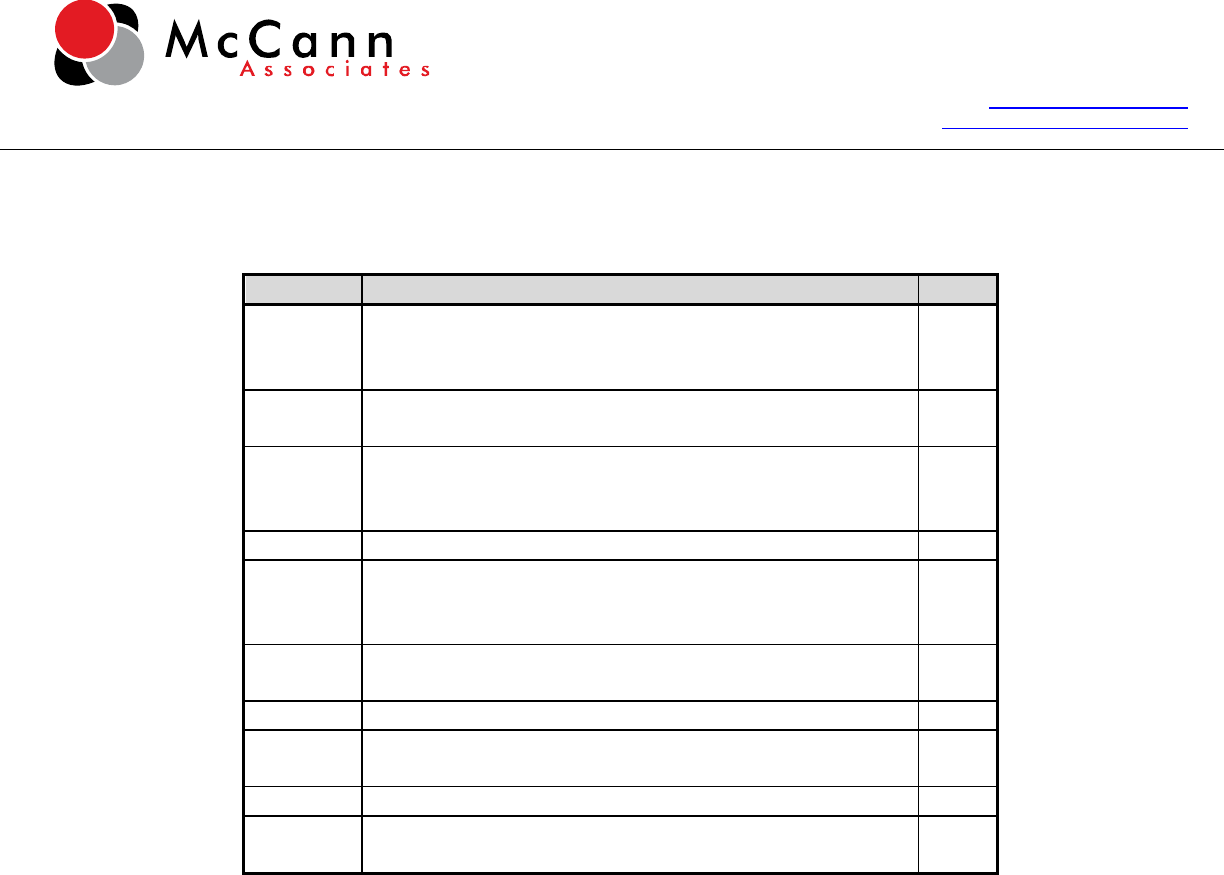
370 Scotch Road, Ewing, NJ 08628
Toll Free: 866.933.0508
Fax: 267.756.1440
www.mccanntesting.com
college.measuredsuccess.com
© Copyright McCann Associates 2011. All Rights Reserved
19
Reading:
Sequence Competency Description Key
1 Discern the most important ideas, events, or
information, and summarize them accurately and
concisely.
B
2 Analyze how the text’s organizational structure
presents the argument, explanation, or narrative.
A
3 Determine what is meant by words and phrases in
context, including connotative meanings and figurative
language.
D
4 Determines the author’s purpose. C
5 Support or challenge assertions about the text by citing
evidence in the text explicitly and determine what can
be inferred logically from the text.
D
6 Analyze how specific details and larger portions of the
text contribute to the meaning of the text.
B
7 Determine what the text says explicitly. D
8 Determine when, where, and why events unfold in the
text, and explain how they relate to one another.
B
9 Recognizes tone. A
10 Delineate the main ideas or themes in the text and the
details that elaborate and support them.
C
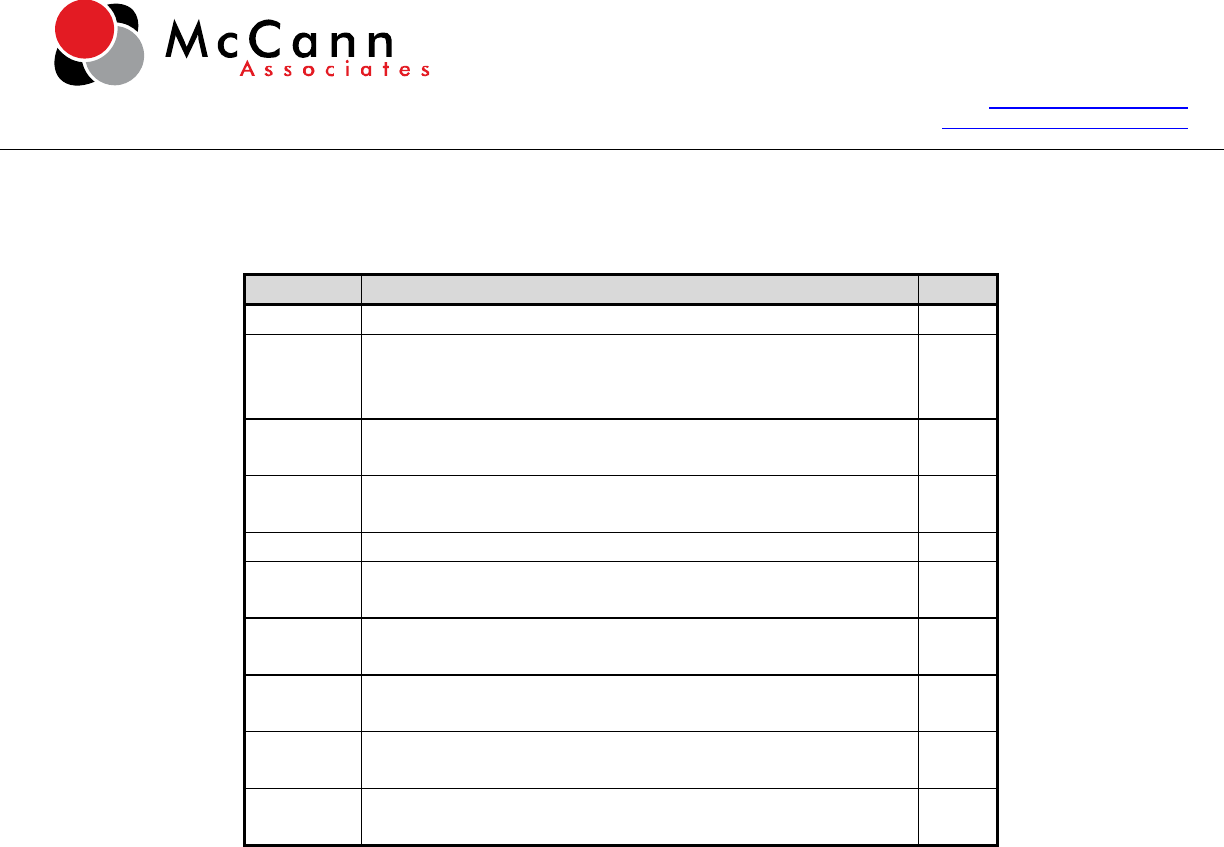
370 Scotch Road, Ewing, NJ 08628
Toll Free: 866.933.0508
Fax: 267.756.1440
www.mccanntesting.com
college.measuredsuccess.com
© Copyright McCann Associates 2011. All Rights Reserved
20
Writing:
Sequence Competency Description Key
1 Sustain focus on a specific topic or argument. C
2 Demonstrate command of the conventions of standard
written English, including grammar, usage, and
mechanics.
A
3 Support and illustrate arguments and explanations with
relevant details, examples, and evidence.
D
4 Create a logical progression of ideas or events, and
convey the relationships among them.
C
5 Sentence Structure Skills: Places modifiers correctly. B
6 Use varied sentence structures to engage the reader and
achieve cohesion between sentences.
D
7 Grammar, Spelling, Capitalization, Punctuation Skills:
Avoids inappropriate shifts in verb tense.
B
8 Grammar, Spelling, Capitalization, Punctuation Skills:
Maintains agreement between pronoun and antecedent.
A
9 Grammar, Spelling, Capitalization, Punctuation Skills:
Avoids inappropriate pronoun shifts.
D
10 Grammar, Spelling, Capitalization, Punctuation Skills:
Uses adjectives and adverbs correctly.
C

370 Scotch Road, Ewing, NJ 08628
Toll Free: 866.933.0508
Fax: 267.756.1440
www.mccanntesting.com
college.measuredsuccess.com
© Copyright McCann Associates 2011. All Rights Reserved
21
Introduction to the Diagnostic Assessment
This booklet has been prepared for faculty and administrators to gain a full understanding
of the diagnostic component of the Postsecondary Education Readiness Test (P.E.R.T.).
The purpose of the P.E.R.T. Diagnostic is to adequately assess students’ academic abilities
in mathematics, reading, and writing while determining areas of improvement on an
individualized basis.
The P.E.R.T. Placement was launched in October 2010 and the diagnostics were designed
as complements. The diagnostic blueprints were derived with developmental education
courses in mind, and the competencies included are required for student proficiency.
P.E.R.T. Diagnostic Assessment
Test Session
The chart below displays the average length of time a student will need to complete each
subtest. The length of time to complete the test is comparable for both lower and upper
versions of the tests.
Test Name Average Duration
PERT Diagnostic Lower or Upper Math 1 hour
PERT Diagnostic Lower or Upper Writing 1 hour
PERT Diagnostic Lower or Upper Reading 1 hour 45 minutes
Testing Format
The P.E.R.T. Diagnostic is delivered through a web based application called College
Success™. Students must take the test in a proctored environment.
Diagnostic Score Report
In the diagnostic reports, students will receive detailed information regarding which
competencies they are proficient or below proficient in. Faculty will utilize the reports to
identify where a student needs additional preparation and will target instruction
accordingly.
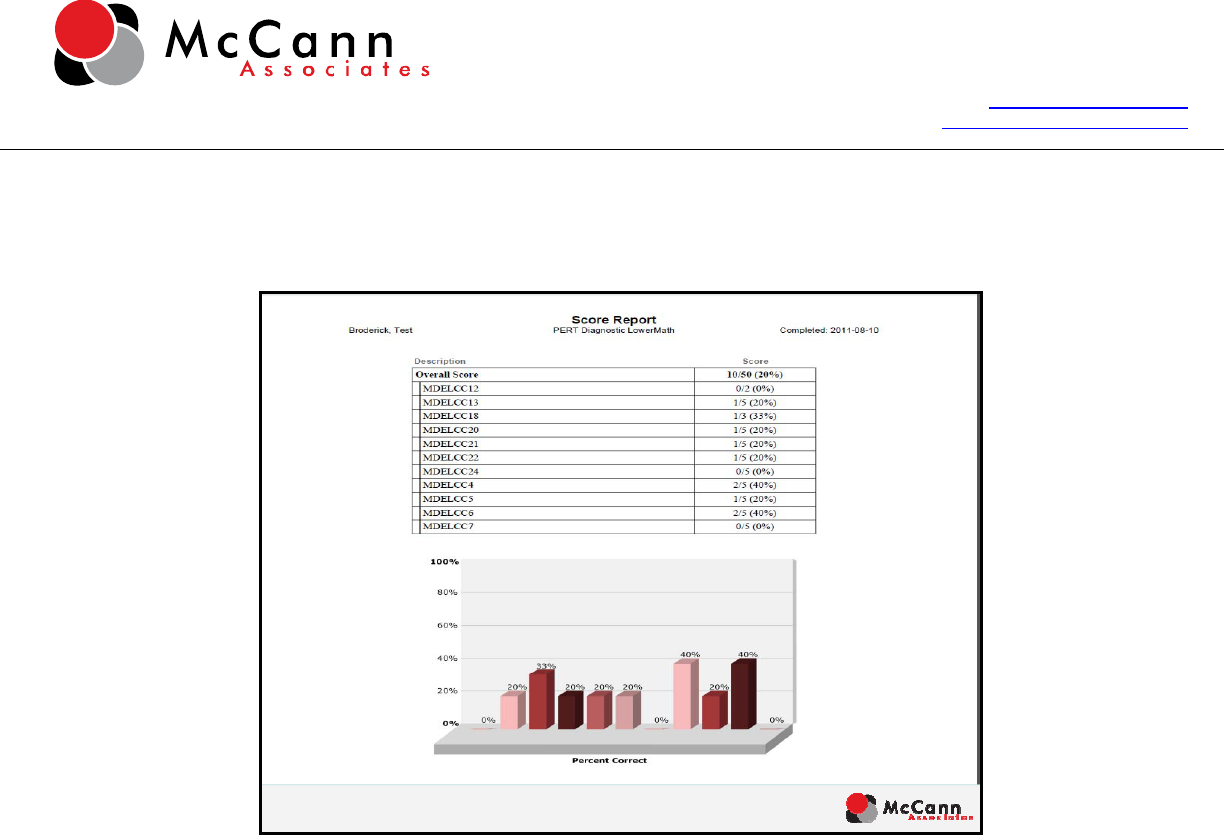
370 Scotch Road, Ewing, NJ 08628
Toll Free: 866.933.0508
Fax: 267.756.1440
www.mccanntesting.com
college.measuredsuccess.com
© Copyright McCann Associates 2011. All Rights Reserved
22
Below is an example of how a diagnostic score report appears. A percentage score is
provided for each competency tested.
Copyright © McCann Associates. All Rights Reserved.
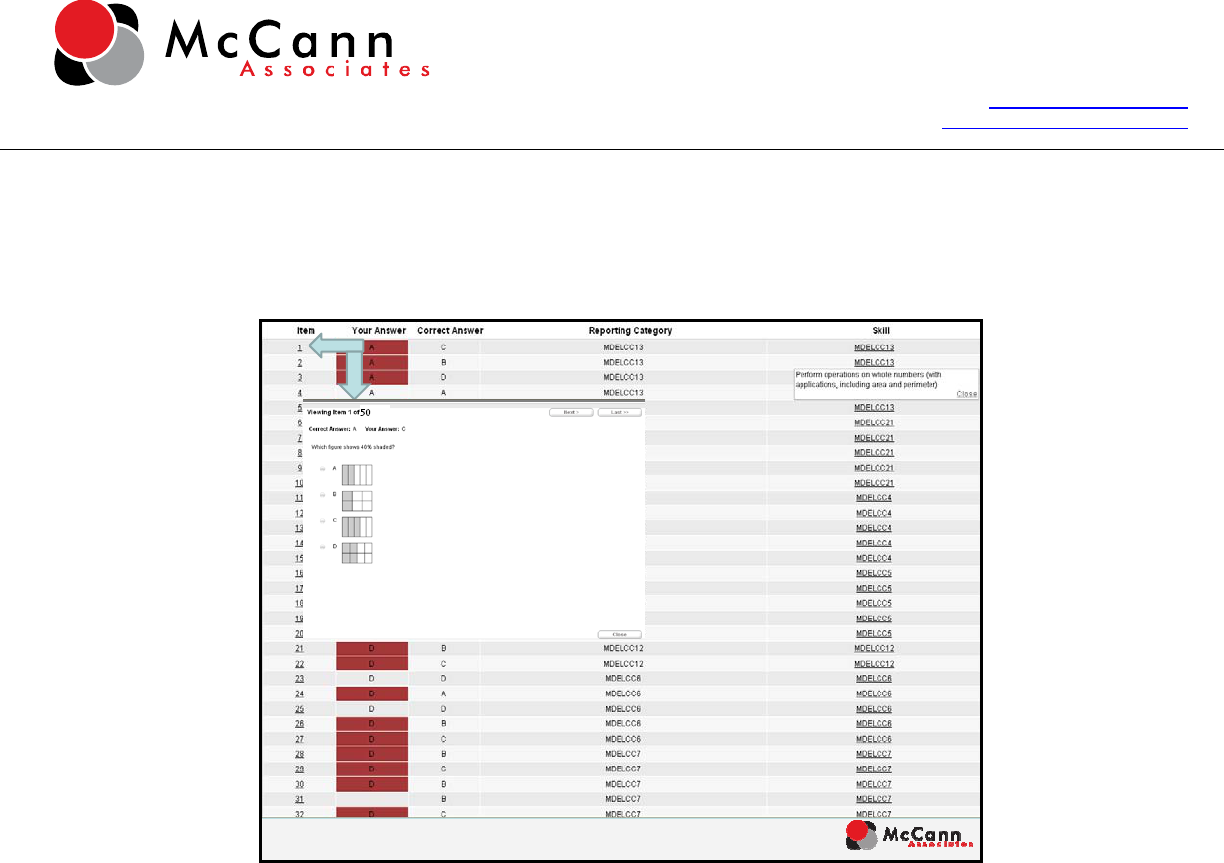
370 Scotch Road, Ewing, NJ 08628
Toll Free: 866.933.0508
Fax: 267.756.1440
www.mccanntesting.com
college.measuredsuccess.com
© Copyright McCann Associates 2011. All Rights Reserved
23
Students are able to click on an item number and review the item, the correct answer, and
the answer that they chose. By clicking on the skill or competency ID, the competency is
displayed.
Copyright © McCann Associates. All Rights Reserved.
Question Formats
All test questions are in a multiple choice format. The Reading Diagnostic includes
passages that students will need to read in order to answer questions. The Mathematics
Diagnostic does not include a built-in calculator as with the Mathematics Placement
assessment.
Test Forms
There is one test form for each subject area and for each level. For example, the Lower
Level Diagnostic has one test form, and the Upper Level Writing Diagnostic has one test
form. Each test contains 50 items. Test forms will be replaced periodically in order to
decrease item exposure as well as pilot new test items.

370 Scotch Road, Ewing, NJ 08628
Toll Free: 866.933.0508
Fax: 267.756.1440
www.mccanntesting.com
college.measuredsuccess.com
© Copyright McCann Associates 2011. All Rights Reserved
24
P.E.R.T. Diagnostic Assessment Content
Lower Level Reading Diagnostic Competencies:
Competency ID Competency Description
Number
of Items
RDELCC1 Distinguish between facts and opinions 5
RDELCC2 Identify the author’s primary purpose as
persuade, inform, or entertain
5
RDELCC3 Identify specific information in a paragraph 5
RDELCC4 Distinguish between major and minor details
in a paragraph
5
RDELCC5 Identify the topic and stated/implied main
idea in a paragraph in print and online
5
RDELCC6 Identify and use context clues to determine
the meaning of words in simple sentences
5
RDELCC7 Identify logical inferences and conclusions
based on the evidence provided in a
paragraph
5
RDELCC8 Identify the following primary patterns of
organization in a paragraph such as time
order, simple listing, and
generalization/definition and example
5
RDELCC9 Identify the transition words that are
associated with each pattern
5
RDELCC11 Recognize relationships within/between
sentences
5
50

370 Scotch Road, Ewing, NJ 08628
Toll Free: 866.933.0508
Fax: 267.756.1440
www.mccanntesting.com
college.measuredsuccess.com
© Copyright McCann Associates 2011. All Rights Reserved
25
Upper Level Reading Diagnostic Competencies:
Competency ID Competency Description
Number of
Items
RDEUCC1 Evaluate the author’s use of facts and
opinions
5
RDEUCC2 Analyze the author’s primary purpose 5
RDEUCC3 Identify the topic and stated/implied main
idea in a multi-paragraph selection in
print and online
5
RDEUCC4 Use contextual clues and structural
analysis to clarify meanings and broaden
academic vocabulary
5
RDEUCC7 Distinguish between major and minor
details in a multi-paragraph selection
5
RDEUCC8 Identify relationships between and/or
within sentences
5
RDEUCC9 Determine the primary and secondary
patterns of organization for a paragraph
and multi-paragraph selection
5
RDEUCC11 Analyze the author’s tone and support
with examples, including denotative,
connotative meaning, and figurative
language
5
RDEUCC12 Detect bias 5
RDEUCC14 Analyze the details to infer what the
author is implying and draw logical
conclusions in a paragraph and multi-
paragraph selection
5
50
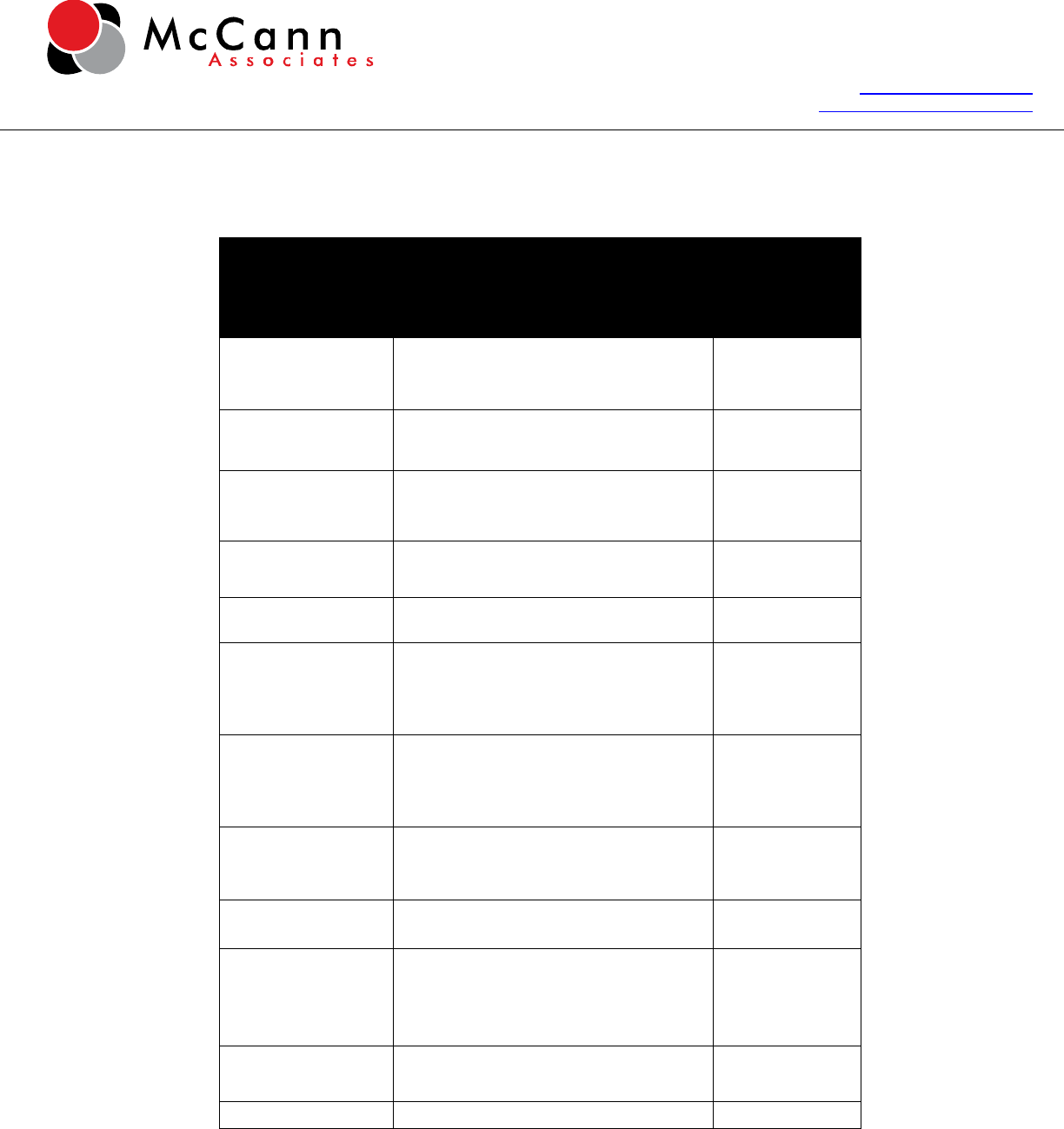
370 Scotch Road, Ewing, NJ 08628
Toll Free: 866.933.0508
Fax: 267.756.1440
www.mccanntesting.com
college.measuredsuccess.com
© Copyright McCann Associates 2011. All Rights Reserved
26
Lower Level Mathematics Diagnostic Competencies:
Competency ID Competency Description
Number of
Items
MDELCC4
Perform operations with integers (with
applications)
5
MDELCC5
Perform operations with fractions
(with applications)
5
MDELCC6
Perform operations with decimals
(with applications)
5
MDELCC7
Convert among percents, fractions, and
decimals
5
MDELCC12
Simplify fractions
2
MDELCC13
Perform operations on whole numbers
(with applications, including area and
perimeter)
5
MDELCC18
Define variables and write an
expression to represent a quantity in a
problem
3
MDELCC20
Simplify algebraic expressions
involving one variable (2x + 5x)
5
MDELCC21
Perform order of operations
5
MDELCC22
Solve linear equations involving the
addition and multiplication property of
equalities
5
MDELCC24
Evaluate exponents with integers
5
50

370 Scotch Road, Ewing, NJ 08628
Toll Free: 866.933.0508
Fax: 267.756.1440
www.mccanntesting.com
college.measuredsuccess.com
© Copyright McCann Associates 2011. All Rights Reserved
27
Upper Level Mathematics Diagnostic Competencies:
Competency ID Competency Description
Number of
Items
MDEUCC3 Apply the order of operations to evaluate
algebraic expressions, including those with
parentheses and exponents
5
MDEUCC8 Solve literal equations for a given variable
with applications (geometry, motion
[d=rt], simple interest [i=prt])
3
MDEUCC9 Solve linear inequalities in one variable
and graph the solution set on a number line
3
MDEUCC10 Graph linear equations using table of
values, intercepts, slope intercept form
5
MDEUCC11 Solve linear equations in one variable
using manipulations guided by the rules of
arithmetic and the properties of equality
6
MDEUCC12 Simplify an expression with integer
exponents
5
MDEUCC15 Add, subtract, multiply, and divide
polynomials. Division by monomials
only. (Does not include division by
binomials)
6
MDEUCC16 Simplify radical expressions - square roots
only
3
MDEUCC17 Add, subtract, and multiply square roots of
monomials
3
MDEUCC18 Factor polynomial expressions (GCF,
grouping, trinomials, difference of
squares)
6
MDEUCC19 Solve quadratic equations in one variable
by factoring
5
50

370 Scotch Road, Ewing, NJ 08628
Toll Free: 866.933.0508
Fax: 267.756.1440
www.mccanntesting.com
college.measuredsuccess.com
© Copyright McCann Associates 2011. All Rights Reserved
28
Lower Level Writing Diagnostic Competencies:
Competency ID Competency Description
Number of
Items
WDELCC1 Sustain focus on a specific main idea for a
single paragraph
5
WDELCC2 Demonstrate a basic command of grammar
(verb tense, verb forms, verb shifts)
6
WDELCC3 Demonstrate a basic command of usage
(pronoun, syntax, appropriate words and
phrases, commonly confused words)
8
WDELCC4 Demonstrate a basic command of
mechanics (punctuation, spelling, caps)
6
WDELCC5 Provide supporting details for main idea
with relevant explanations and examples, in
a single paragraph
5
WDELCC6 Select and narrow a topic that addresses the
specific purpose
4
WDELCC7 When writing use complete sentences /
recognize fragments
6
WDELCC8 Recognize run-ons (comma splices and
fused sentences)
5
WDELCC9 Maintain agreement between subjects and
verbs
5
50

370 Scotch Road, Ewing, NJ 08628
Toll Free: 866.933.0508
Fax: 267.756.1440
www.mccanntesting.com
college.measuredsuccess.com
© Copyright McCann Associates 2011. All Rights Reserved
29
Upper Level Writing Diagnostic Competencies:
Competency ID Competency Description
Number of
Items
WDEUCC1 Demonstrate a command of grammar
(verb tense, verb forms, verb shifts)
8
WDEUCC2 Demonstrate a command of usage
(syntax, appropriate words and
phrases, commonly confused words)
5
WDEUCC3 Demonstrate a command of mechanics
(punctuation, spelling, capitalization)
6
WDEUCC4 Identify effective transitional devices
within the context of a passage
4
WDEUCC5 Use coordination and subordination
effectively
5
WDEUCC6 Use pronouns correctly (case,
agreement, shifts, reference)
5
WDEUCC7 Use adjectives and adverbs correctly,
including degree forms
5
WDEUCC8 Identify fragments, comma splices, and
fused sentences
6
WDEUCC9 Maintain agreement between subject
and verb
6
50

370 Scotch Road, Ewing, NJ 08628
Toll Free: 866.933.0508
Fax: 267.756.1440
www.mccanntesting.com
college.measuredsuccess.com
© Copyright McCann Associates 2011. All Rights Reserved
30
Sample P.E.R.T. Diagnostic Questions
PERT Diagnostic Sample Mathematics Items
PERT Diagnostic Standard MDELCC7
Convert among percents, fractions, and decimals
Convert to percent notation:
A. 0.4%
B. 4%
C. 40%
D. 400%
PERT Diagnostic Standard MDELCC13
Perform operations on whole numbers (with applications, including area and perimeter)
Jon has $442 in his bank account. He spends $29 on gas and $68 on dinner. How much
money is left in Jon’s bank account after these purchases are made?
A. $345
B. $355
C. $365
D. $403
PERT Diagnostic Standard MDELCC21
Perform order of operations
Simplify:
2(2 + 1) + (7 – 2)
2
A. 8
B. 9
C. 30
D. 31
PERT Diagnostic Standard MDELCC22
Solve linear equations involving the addition and multiplication property of equalities

370 Scotch Road, Ewing, NJ 08628
Toll Free: 866.933.0508
Fax: 267.756.1440
www.mccanntesting.com
college.measuredsuccess.com
© Copyright McCann Associates 2011. All Rights Reserved
31
Solve for x:
8x = -32
A. -40
B. -24
C. -4
D. 4
PERT Diagnostic Standard MDELCC24
Evaluate exponents with integers
Evaluate the following:
(-8)
2
A. -64
B. -16
C. 16
D. 64
PERT Diagnostic Sample Reading Items
PERT Diagnostic Standard RDELCC4
Distinguish between major and minor details in a paragraph
Read the selection and answer the question.
(1) In Cologne, Germany, on April 21, 2006, Frank "Anti Terror" Stoldt stepped
into the ring with Zoran "The Priest" Mijatovic. (2) The two men traded barbs for
several rounds, but after the 5
th
round, Mijatovic unleashed his full fury on Stoldt with a
flurry of body punches, haymakers, and jabs. (3) One could scarcely make out
Mijatovic's hands in the blur of punches; Mijatovic was looking for a knockout. (4)
Stoldt withstood the bevy of blows and staggered to his corner after the round. (5)
Mijatovic had missed his opportunity to end the match and after losing his rook,
realized he was three moves away from checkmate and resigned the match. (6) Battered
and bloodied, Frank Stoldt's arms were raised in victory in the 7
th
round; he had
withstood Mijatovic's fury and now qualified for the Chessboxing world title fight to be
held the following year.
(7) Chessboxing is a relatively new sport, holding its first European championship
bout in 2005. (8) The match consists of up to 11 alternating rounds of boxing and speed
chess with one-minute breaks between rounds. (9) Combatants must be at least a Class-

370 Scotch Road, Ewing, NJ 08628
Toll Free: 866.933.0508
Fax: 267.756.1440
www.mccanntesting.com
college.measuredsuccess.com
© Copyright McCann Associates 2011. All Rights Reserved
32
A-level chess player and an experienced boxer. (10) Competitors can win via knockout,
checkmate, or judges' decision. (11) During chess rounds, combatants are given a
warning if they do not make a move and may be disqualified if warned too often and
must wear headphones during the chess portions so as to ignore any assistance offered
by the crowd. (12) A rather unusual but oddly egalitarian entry into the eternal struggle
of Brains vs. Brawn.
According to this selection, sentence (1) is a —
A. major detail.
B. topic statement.
C. minor detail.
D. thesis statement.
PERT Diagnostic Standard RDELCC5
Identify the topic and stated/implied main idea in a paragraph in print and online
Read the selections and answer the question.
Pro
(1) For this upcoming school year, I think all the students of Alexander Hamilton
High School should be able to choose their classes. (2) If the goal of high school is to
get good grades and qualify for a good college, then why should we be denied the right
to maximize our strengths? (3) I don't like the idea of some big central authority
influencing and determining the grade market; I have known myself for more than a
decade, so I'm certain I know my own strengths and weaknesses, and it's high time that
some college gets a full view of those strengths. (4) Not that I would horde good grades
in areas where I excel, such as math and science, but I think I have the right to
determine my educational future rather than some all-powerful central educational
authority that may not have my best interests in mind.
Con
(5) The purpose of a high school is to offer a well-rounded education; college is an
advanced institution where you can build on your strengths. (6) If you shine in
mathematics and maintain respectable grades in your other subjects, you will attract the
attention of colleges offering degrees in those programs. (7) However, your central
claim that the aim of high school is to vet potential college students is off the mark, as
the percentage of students who go on to college in this school and across the country is
significantly lower than 100%. (8) Likewise you used the word "horde" when you
meant "hoard," and if you were to do some research into our school's namesake and his
battle to create a national bank (i.e., "some big central authority influencing and
determining the market") you might reconsider reframing your argument or at least

370 Scotch Road, Ewing, NJ 08628
Toll Free: 866.933.0508
Fax: 267.756.1440
www.mccanntesting.com
college.measuredsuccess.com
© Copyright McCann Associates 2011. All Rights Reserved
33
look into some historical counterarguments. (9) The aim of high school is to impart
knowledge. (10) Think of how much improved your claim would look had you more
experience in debate, English, and history, which you no doubt will have during your
time at Alexander Hamilton High.
The best title for both of the arguments in the selection would be —
A. Education: Whose Choice Should It Be?
B. Alexander Hamilton: Pro Business or Pro Government?
C. High School Confidential: Your Educators Know Best, And You Will Too!
D. Building On Strength: Maximize Education By Concentrating On What You Do
Best
PERT Diagnostic Standard RDELCC6
Identify and use context clues to determine the meaning of words in simple sentences
Read the selection and answer the question.
(1) In March 2002, Gavin Menzies, an amateur British historian, made a surprising
announcement to the Royal Geographical Society in England. (2) He claimed that a
Chinese sailor named Zheng He (pronounced "jung huh") reached America and sailed
around the world at least 70 years before Columbus!
(3) During his research, Menzies reportedly found an old map dated 1459 that
showed the tip of southern Africa and the Cape of Good Hope; however, those parts of
the world were supposedly unknown in Europe until Vasco da Gama's voyage in 1497,
and Menzies believes that map came originally from China. (4) In the 1400s, the
Chinese had the largest navy in the world and were undoubtedly the masters of the sea,
having built ships much larger than European ships with rudders
and watertight
compartments and compasses for navigation. (5) According to Chinese historians, an
emperor of the Ming dynasty ordered Zheng He to travel to countries beyond the
horizon and to the end of the earth. (6) From 1405 to 1433, historians agree that Zheng
He sailed throughout Southeast Asia to India, to parts of Africa, and to the land now
called Australia. (7) According to Gavin Menzies, Zheng He then sailed around the
southern tip of Africa on that voyage and across the Atlantic Ocean to some islands in
the Caribbean where, Menzies reports, evidence of nine Chinese shipwrecks in the
Caribbean that date back to the 1400s have been discovered. (8) Then, according to
Menzies, Zheng He sailed south around the tip of South America, up the coast as far as
the land that is now Mexico, and across the Pacific Ocean back to China. (9) If so, then
Zheng He was the first person to sail around the world and the first explorer to reach
the Americas. (10) It may turn out that the European explorers were actually
rediscovering places that Admiral Zheng He had already visited many years before.

370 Scotch Road, Ewing, NJ 08628
Toll Free: 866.933.0508
Fax: 267.756.1440
www.mccanntesting.com
college.measuredsuccess.com
© Copyright McCann Associates 2011. All Rights Reserved
34
Which of the following is the best definition of the word "rudders" as used in Sentence 4?
A. Guiding forces
B. Underwater blades that help steer vessels
C. Trembling nervously, quivering, or shaking
D. Ancient ships that were larger than any others
PERT Diagnostic Standard RDELCC7
Identify logical inferences and conclusions based on the evidence provided in a paragraph
Read the selection and answer the question.
Hello, Imran:
(1) And how does this miserable, sticky, and hopelessly stinking evening find you?
(2) Please do not gloat in your reply, as I can already imagine you at home with your
videogames in the full air-conditioned glory that is the modern world—though I guess
that would eventually bore me as well. (3) Sadly, I remain at summer camp for a third
excruciating week. (4) How are the bugs over there? (5) Nonexistent you say? (6) Well,
here I beg for flies, as they rarely get a chance to bite me, for they are eaten by cicadas,
which, in turn, are consumed by massive bees that live in the ground, and those bees are
what make it to my cabin and bite or sting me (often both). (7) Here at what I'll call
Camp Cretaceous we're treated to bugs larger than those that harassed the dinosaurs,
would that I were just to experience some bugs lower on the food chain instead of these
flying monsters the size of tennis balls that I swear I once saw attack and carry off a
squirrel. (8) The counselors, the activities, and the food are alike in that they are bland,
sticky, and not nourishing on any level. (9) Please, Imran, write back that the power has
been off for days, or that our beloved hometown has been under martial law, or some
other malady has befallen our neighborhood so that you may share in my misery. (10)
Did I mention that everything here, even the water, is unnaturally sticky?
Send Help,
Toby
The reader can infer that Toby —
A. is attending a camp about dinosaurs.
B. complains a lot and is difficult to please.
C. wishes that Imran could join him at the camp.
D. is trying to stay positive and make the best of things this summer.

370 Scotch Road, Ewing, NJ 08628
Toll Free: 866.933.0508
Fax: 267.756.1440
www.mccanntesting.com
college.measuredsuccess.com
© Copyright McCann Associates 2011. All Rights Reserved
35
PERT Diagnostic Standard RDELCC9
Identify the transition words that are associated with each pattern
Read the selection and answer the question.
(1) Long ago, ancient peoples would visit the Oracle of Delphi. (2) The city of
Delphi was thought to be the center of the world. (3) In Greek mythology, this place
belonged to the god Apollo. (4) His words were supposedly spoken through the oracle.
(5) The oracle was a mysterious woman who sat on a three-legged stool and answered
people's questions after taking deep breaths from a hole in the ground. (6) The Greeks
explained that special gases from the ground helped the woman see through mysteries
of the universe.
(7) The oracle itself was a great mystery, and for many years, scientists considered
the idea of the oracle and the gases foolish. (8) Recently, however, scientists have made
some interesting discoveries. (9) When building a road over present-day Delphi,
workers uncovered several fault lines around the temple complex extending deep into
the ground that emitted ethylene, a sweet-smelling gas that can make people feel oddly
joyful and see things that are not there. (10) Now scientists know that the oracle at
Delphi was more than just hot air.
Which of the following is the pattern of organization demonstrated by the use of the word
"however" in Sentence 8?
A. Classification and example
B. Chronological order
C. Cause and effect
D. Comparison and contrast
PERT Diagnostic Sample Writing Items
PERT Diagnostic Standard WDELCC2
Demonstrate a basic command of grammar (verb tense, verb forms, verb shifts)
Which of the following choices correctly completes the sentence?
Once the planetarium closed for the day, Allen and Diane ____ to a diner and ate
dinner.
A. go
B. had gone
C. went
D. would go

370 Scotch Road, Ewing, NJ 08628
Toll Free: 866.933.0508
Fax: 267.756.1440
www.mccanntesting.com
college.measuredsuccess.com
© Copyright McCann Associates 2011. All Rights Reserved
36
PERT Diagnostic Standard WDELCC3
Demonstrate a basic command of usage (pronoun, syntax, appropriate words and phrases,
commonly confused words)
Choose the sentence in which the underlined word is used correctly.
A. Johnny's ruined desk bore the scars of all those delinquent students who preceded
him at the academy.
B. The second president of the United States, John Adams, preceded our nation's first
commander-in-chief, George Washington.
C. During low tide, the headwaters finally preceded back into the ocean, leaving the
beach dry and the morning's sand castle destroyed.
D. Despite the technical gaffe that interrupted the play for a full seven minutes, the
performers preceded with the second act, acquitting themselves quite well.
PERT Diagnostic Standard WDELCC8
Recognize run-ons (comma splices and fused sentences)
Choose the sentence that is correct.
A. Some dinosaurs, like the Tyrannosaurus, are terrifying; however, other dinosaurs,
like the feathered Caudipteryx, are downright adorable.
B. Some dinosaurs, like the Tyrannosaurus are terrifying however other dinosaurs, like
the feathered Caudipteryx, are downright adorable.
C. Some dinosaurs, like the Tyrannosaurus are terrifying; and other dinosaurs, like the
feathered Caudipteryx, are downright adorable.
D. Some dinosaurs, like the Tyrannosaurus are terrifying, however other dinosaurs,
like the feathered Caudipteryx, are downright adorable.
PERT Diagnostic Standard WDELCC5
Provide supporting details for main idea with relevant explanations and examples, in a
single paragraph
Read the selection and answer the question.
(1) Although African and Asian elephants have dissimilar features, their differences
serve similar functions and are better suited to the environments of each species. (2)
Elephants are famous for their big front teeth called tusks. (3) Among Asian elephants,
only the males have tusks. (4) Both male and female African elephants have tusks, and
their tusks are larger than the Asian elephants’ tusks. (5) __________. (6) African
elephants also have larger ears and more body mass, and these large ears act as a fan to
keep the elephant cool. (7) These differences are likely related to the different
environments of the animals. (8) African elephants must have large ears to keep the

370 Scotch Road, Ewing, NJ 08628
Toll Free: 866.933.0508
Fax: 267.756.1440
www.mccanntesting.com
college.measuredsuccess.com
© Copyright McCann Associates 2011. All Rights Reserved
37
animal cool in the hot savanna sun, while the Asian elephant must be smaller to better
navigate the dense forests of India and surrounding countries. (9) Imagine what an
elephant would look like in a totally different environment; it would be a mammoth
accomplishment to picture an elephant that could roam around in the cold, for example.
Which of the following sentences could the writer insert after sentence 4 in order to provide
the best support for the main idea expressed in sentence 1?
A. Elephants are famous for their big front teeth called tusks.
B. If you look carefully, you can tell the difference between an Asian and an African
elephant.
C. African elephants have bigger ears than Asian elephants; also these ears are shaped
differently with the Asian elephant having ears around three times smaller than their
African counterparts.
D. Scientists theorize that the smaller tusks on Asian elephants are an environmental
response to over poaching in the area where larger-tusked elephants were more
often killed for ivory.
PERT Diagnostic Standard WDELCC7
When writing use complete sentences / recognize fragments
Read the selection and answer the question.
(1) In America, it is illegal to create any independent currency. (2) However, I find
the dollar intolerable and am concerned that its value keeps moving around. (3)
Furthermore, the idea that the dollar is not tied to any fixed asset like gold or silver
makes me cringe. (4) We need to adopt a currency that more suits my needs. (5)
Alternative currencies such as gold or silver coins, trading goods and services, the
guilder, checks drawn from bank accounts, or even trading manual labor or some
similar service. (6) While nations and currencies rise and fall over the centuries,
everything gold can stay.
Which of the following sentences is NOT correct?
A. Sentence 2
B. Sentence 3
C. Sentence 4
D. Sentence 5
